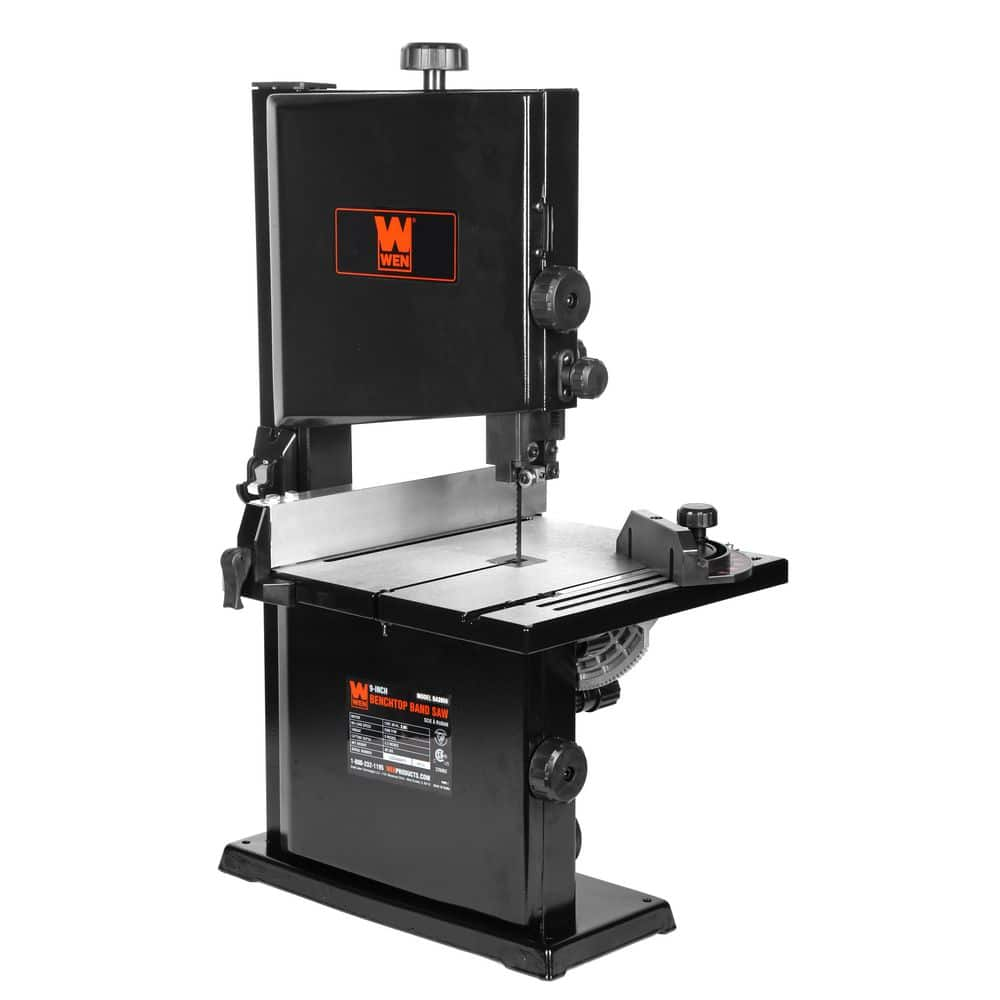If you’ve ever wondered just how loud a bandsaw can be, you’re in the right place! We’re here to uncover the decibels and give you a sneak peek into what you can expect from this powerful tool. Ready to dive in and discover the noise levels of a bandsaw?
When it comes to power tools, noise can play a big role. Whether you’re a curious DIY enthusiast or a budding woodworking aficionado, understanding the noise produced by a bandsaw is essential. Let’s explore the world of bandsaws and find out how loud they can really get.
From the roar of the motor to the whir of the blade, the sound of a bandsaw in action can be quite captivating. So, if you’re ready to brave the noise and embark on a sonic adventure, keep reading to learn just how loud a bandsaw can be. Get your earplugs ready, folks!

How Loud is a Bandsaw?
When it comes to woodworking tools, one of the key factors to consider is the noise level. Noisy machinery can be disruptive and potentially harmful to your hearing. This is especially true for bandsaws, which are known for their powerful cutting capabilities. In this article, we will explore just how loud a bandsaw can be and discuss some ways to minimize the noise for a more pleasant woodworking experience.
Understanding Decibels and Sound Levels
To accurately determine the loudness of a bandsaw, we need to understand decibels and how sound levels are measured. Decibels (dB) are the units used to measure sound intensity. The higher the decibel level, the louder the sound. For reference, a normal conversation typically ranges between 40-60 dB, while a jet engine can reach a deafening 140 dB.
So, where does a bandsaw fall on this scale? On average, a typical bandsaw operates at around 90 dB. This is comparable to the noise level of a motorcycle or a lawnmower. However, it’s important to note that the specific noise level can vary depending on factors such as the model, blade type, and cutting materials.
Now that we have a better understanding of decibels and sound levels, let’s explore some effective ways to reduce the noise produced by a bandsaw.
Minimizing Bandsaw Noise
1. Invest in Quality Soundproofing:
One of the most effective ways to reduce the noise level of a bandsaw is to invest in quality soundproofing materials. Acoustic panels, foam insulation, and sound curtains can help absorb and dampen the noise generated by the machine. By strategically placing these materials around your workshop, you can significantly reduce the overall noise level.
2. Opt for a Reliable Bandsaw Model:
When purchasing a bandsaw, it’s important to choose a model known for its low noise output. Look for brands that prioritize sound reduction in their designs. The technology and engineering behind the bandsaw can greatly impact its noise level. Reading reviews and consulting with experienced woodworkers can help you find a quieter bandsaw option.
3. Maintain and Lubricate the Bandsaw:
A poorly maintained or unlubricated bandsaw can create unnecessary noise. Regularly cleaning and lubricating the machine’s moving parts can minimize friction and reduce the noise level. Additionally, keeping the bandsaw blade properly tensioned and adjusted can prevent excessive vibrations and noise.
4. Use Sound-Absorbing Flooring:
The type of flooring in your workshop can also influence the overall noise level. Concrete floors, for example, can reflect sound waves and amplify noise. Consider installing sound-absorbing flooring materials, such as rubber mats or cork tiles, to help absorb and dampen the sound produced by the bandsaw.
Ensuring Safety While Reducing Noise
While it’s important to minimize the noise generated by a bandsaw for a more comfortable woodworking environment, safety should always be a top priority. Make sure to wear appropriate hearing protection, such as earmuffs or earplugs, when operating a bandsaw. Additionally, always follow proper safety protocols and wear safety goggles and other protective equipment to prevent accidents.
Tips for a Quieter Bandsaw Experience
Now that we’ve covered the basics of bandsaw noise and ways to reduce it, let’s explore some additional tips for a quieter and more enjoyable woodworking experience:
1. Set Up a Dedicated Workshop Space:
Having a dedicated workshop space allows you to properly soundproof the area and minimize noise leakage. Separating your woodworking activities from other areas in your home can help create a more peaceful environment.
2. Consider Time Restrictions:
If you live in close proximity to neighbors or have noise-sensitive family members, it may be helpful to establish time restrictions for using your bandsaw. By limiting the hours of operation during periods when noise can be the most disruptive, you can maintain a good relationship with those around you.
3. Use Dampening Techniques:
In addition to soundproofing your workshop, there are other ways to dampen the noise produced by a bandsaw. Placing rubber pads or foam under the feet of the machine can help reduce vibrations and subsequent noise transmission.
Common FAQs
1. Are there any specific bandsaw models known for their low noise output?
While noise levels can vary between models and brands, some bandsaw companies prioritize sound reduction in their designs. Some popular bandsaw models known for their low noise output include the Jet JWBS-14DXPRO, Laguna Tools MBAND1412-175, and RIKON 10-305.
2. Can I add additional insulation to my existing bandsaw to reduce noise?
Yes, adding additional insulation to your bandsaw can help reduce noise. Acoustic panels, foam insulation, and sound barriers can be installed around the machine to absorb and dampen the noise. Just make sure that the added insulation does not interfere with the bandsaw’s functioning or safety features.
3. Can wearing earplugs alone protect my hearing while using a bandsaw?
While wearing earplugs is an important safety measure and can protect your hearing to an extent, it’s recommended to use additional hearing protection, such as earmuffs, especially when operating noisy machinery like a bandsaw. The dual protection can provide better safety and reduce the risk of hearing damage caused by prolonged exposure to loud noise levels.
Conclusion
Understanding the noise level of a bandsaw and implementing strategies to reduce it can greatly enhance your woodworking experience. By investing in quality soundproofing materials, opting for a quieter bandsaw model, and maintaining the machine properly, you can create a more peaceful and enjoyable workshop environment. Remember to prioritize safety by wearing hearing protection and following proper woodworking protocols. With these tips, you’ll be well-equipped to handle the noise while creating beautiful pieces with your bandsaw.
Key Takeaways: How Loud is a Bandsaw?
- A bandsaw can be quite loud, reaching noise levels up to 100 dB.
- This level of noise is similar to the noise produced by a motorcycle or a power lawn mower.
- Exposure to high noise levels can damage your hearing, so it’s important to wear ear protection when using a bandsaw.
- There are quieter models of bandsaws available, so consider purchasing one if noise is a concern for you.
- Regular maintenance and proper blade tensioning can help reduce the noise levels of a bandsaw.
Frequently Asked Questions
Welcome to our guide on bandsaw noise levels! Below, you’ll find answers to some commonly asked questions about how loud a bandsaw can be. Whether you’re a woodworking enthusiast or just curious about the noise produced by power tools, we’ve got you covered. Read on to learn more!
How does the noise level of a bandsaw compare to other power tools?
While noise levels can vary depending on the specific model and brand, in general, a bandsaw tends to produce moderate noise levels compared to other power tools. For example, a bandsaw usually produces less noise than a circular saw, but more noise than a jigsaw. It’s important to note that prolonged exposure to loud noise can still cause hearing damage, so it’s always recommended to wear proper ear protection when operating any power tool.
Some factors that can affect the noise level of a bandsaw include the power of the motor, the quality of the blades, and the material being cut. Regular maintenance and using a well-tensioned blade can help minimize noise levels.
Is it possible to reduce the noise level of a bandsaw?
Yes, it is possible to reduce the noise level of a bandsaw with a few simple steps. One effective method is to use sound-dampening materials or install sound-absorbing panels around the bandsaw. These materials help absorb and minimize the noise produced during operation. Additionally, placing the bandsaw on a vibration-dampening surface, such as a rubber mat, can help reduce noise.
Keeping the bandsaw well-maintained is also crucial for noise reduction. Regularly lubricating the moving parts, ensuring the blade is properly tensioned, and replacing worn-out components can all contribute to a quieter operation. Lastly, wearing proper hearing protection, such as earmuffs or earplugs, is always recommended to protect your hearing when using a bandsaw.
Are there any regulations or guidelines regarding bandsaw noise levels in the workplace?
In many countries, there are regulations and guidelines in place to protect workers from excessive noise levels in the workplace. These regulations typically set limits on the acceptable noise exposure levels and require employers to provide hearing protection if noise levels exceed the limits. The specific regulations and guidelines may vary depending on the country and industry.
It’s essential for employers to assess the noise levels in their workplace and take appropriate measures to protect their employees. This can include implementing engineering controls to reduce noise levels, such as soundproofing the work area or using noise-reducing enclosures for the bandsaws. Providing workers with proper hearing protection and educating them about the potential risks of noise exposure is also crucial for their safety.
Can the noise level of a bandsaw cause hearing damage?
Yes, prolonged exposure to loud noise from a bandsaw or any other power tool can cause hearing damage. The human ear is sensitive to sounds above 85 decibels (dB), and continuous exposure to high noise levels can lead to gradual hearing loss over time. The noise level of a typical bandsaw can range from around 80 to 100 dB, depending on various factors such as the power of the motor and the material being cut.
To protect your hearing, it’s important to wear proper hearing protection, such as earmuffs or earplugs, when operating a bandsaw or any other power tools that generate loud noise. Taking regular breaks from exposure to loud noise, maintaining a safe distance from the source of noise, and minimizing noise exposure whenever possible are also recommended preventive measures.
What are the benefits of using a bandsaw with lower noise levels?
Using a bandsaw with lower noise levels offers several benefits. Firstly, it creates a more comfortable working environment, reducing the risk of noise-related stress or fatigue. Lower noise levels can also contribute to increased concentration and productivity, as excessive noise can be distracting and make it challenging to focus on the task at hand.
Additionally, quieter bandsaws can be more pleasant to work with, especially in shared workspaces or residential areas where noise complaints may be a concern. Lower noise levels can help maintain a harmonious relationship with neighbors or coworkers. Lastly, reducing noise levels can contribute to overall health and safety by minimizing the risk of hearing damage for both operators and those nearby.

Summary
So, how loud is a bandsaw? The answer is that it can vary depending on the specific model and settings. Generally, bandsaws are loud machines that can produce noise levels above the safe limit for hearing. It’s important to wear ear protection when using a bandsaw to protect your ears from potential damage. Remember, safety first!
To minimize the noise produced by a bandsaw, you can consider adding insulation or soundproofing materials to the machine or the surrounding area. Additionally, regular maintenance and lubrication can help reduce the noise levels. Always follow the manufacturer’s instructions and guidelines for proper usage and safety precautions. Stay safe and protect your hearing when using a bandsaw!
